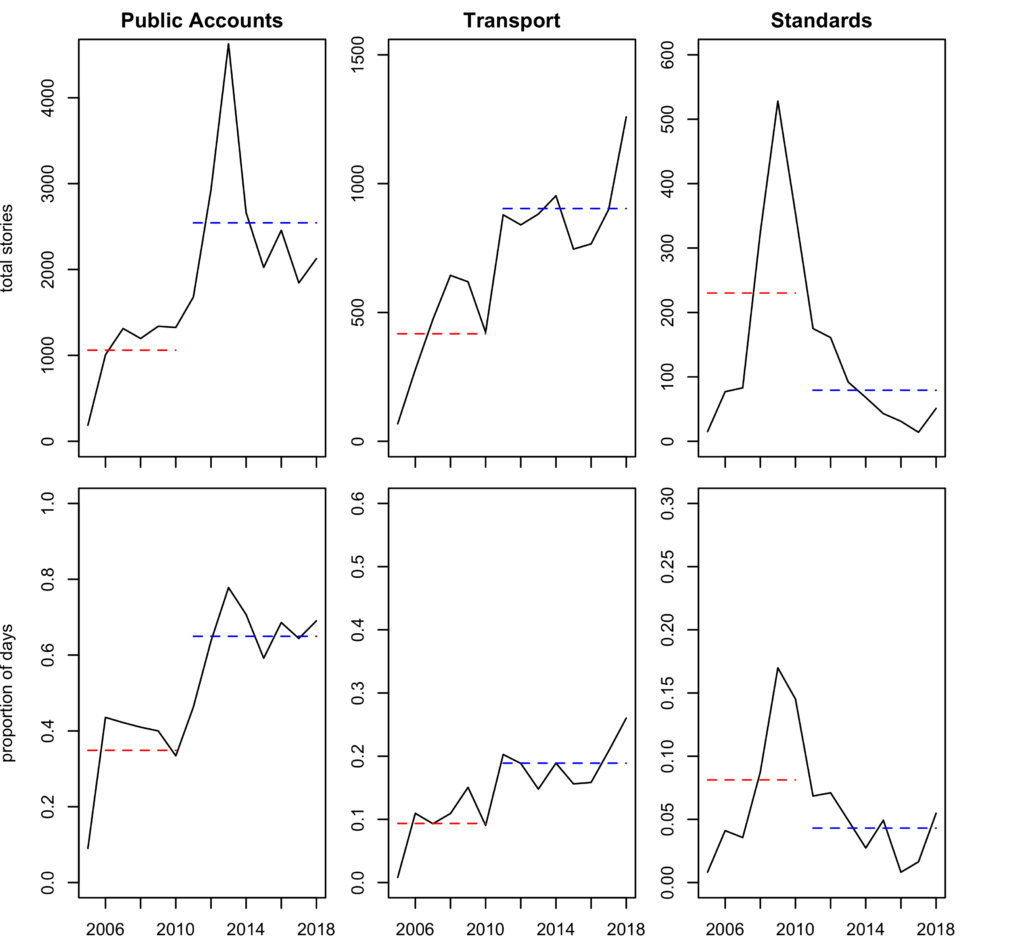When select committees speak, do newspapers listen?
It is frequently claimed that the House of Commons’ select committees have grown in prominence since key reforms were implemented in 2010. Brian J. Gaines, Mark Goodwin, Stephen Holden Bates and Gisela Sin test this claim specifically in relation to press coverage. They find a pattern of increased newspaper attention after the reforms, but caution that these results show no consistent sustained increase, and also vary considerably depending on committee.

Picture: Steve Buissinne from Pixabay
As we write, in early October 2019, it is obvious that the UK Parliament can sometimes make life very difficult for the Prime Minister. There are more chapters to come in the strange saga of Brexit, and Boris Johnson – fencing with the Opposition, Speaker, Supreme Court and rebels newly ejected from his party – may yet prevail. In more normal times, the powers of Parliament can perhaps be far harder to detect. One of the key institutions for legislative-executive interaction – that is, for the Parliament to scrutinise the government and hold it to account – is the select committee. The Wright reforms of 2010 introduced a set of reforms intended to increase the independence and power of these bodies. Did they work?
In 2013, Democratic Audit featured an intriguing and innovative analysis of how Parliament had ‘bounced back’ in media visibility after the Wright reforms. The authors, Patrick Dunleavy and Dominic Muir, used the Lexis-Nexis database to count newspaper articles mentioning select committees over the years 2008–12. They found a surge in coverage, especially, but not exclusively, for the four most newsworthy committees, Home Affairs, Public Accounts, Treasury, and Culture, Media and Sport. In turn, they concluded that the Wright reforms seemed to be working, at least insofar as these committees were, indeed, gaining in prominence.
We have recently published a replication and extension of that analysis in the Journal of Legislative Studies. We also counted newspaper stories, but, noting that the Lexis-Nexis database has many duplicate records, not trivially removed, we also measured salience in a second way, by the proportion of days in a calendar year that each committee garnered any newspaper attention. The latter measure is deliberately insensitive to bursts of attention surrounding unusually splashy events (e.g. hearings about the role of banks in the 2008 financial crisis or about media outlets illegally hacking phone lines and/or engaging in bribery). Instead, it measures how steadily the objects (here, House of Commons select committees) garner newspaper coverage, eschewing measurement of variations in intensity of this coverage.
In brief, we found that select committees continue to make the papers more often than they used to before the Wright reforms, and also before the introduction in 2012 of a new select committee core task: ‘To assist the House of Commons in better engaging with the public
by ensuring that the work of the committee is accessible to the public’. However, we also uncovered some reasons to qualify these findings. First, the committees differ dramatically in levels of coverage and in the trends over the 2005–2018 period we examined. For instance, in terms of story counts, the Home Affairs and Public Accounts select committees, soaring in coverage in 2012, saw declines thereafter; whereas the Treasury, Transport, and International Development select committees were steadily gaining over the years 2010–2018, from high, medium, and low base levels of attention (i.e., 2010 story-count values). In most cases, there is no sign of steadily rising coverage post-Wright, though the simple mean level of coverage is somewhat higher after the reforms than it was before.
An important qualification to any conclusion based on total newspaper stories is that the Lexis-Nexis database covers more papers in later years than earlier ones. To avoid mistaking growth in the dataset for growth in newsworthiness, we also inspected time series of story counts for select papers, The Guardian and The Times. Broadly, those data also reflect an average increase in story counts after the Wright reforms took effect. But which committees stand out as displaying statistically significant increases varies by source, alerting us to be extra cautious about strong conclusions. Digital newspaper-story archives are a wonderful resource, but using them is not necessarily simple.
Whereas the most newsworthy committees (Public Accounts and Treasury) were making these papers about 40 percent of the time (that is, about 150 days per year) before Wright, afterwards they were in the news over 60 percent of the time (220 days or more). But other committees saw declines, for instance, from just under 10 percent to below 5 percent for the Standards and Privileges select committee.
Our article presents analysis of 25 select committees over 14 years. To give some sense of how conclusions depend on which committee(s) one inspects, the figure below shows just three examples of distinctive patterns in our two measures of newsworthiness. Note that the vertical axes differ – moving across panels left to right, visibility is declining. In each case, the dashed lines show average levels before (red) and after (blue) the Wright reforms, that is, 2005–10 versus 2011–18.
Figure 1. Newspaper coverage for three select committees, 2005–2018, by total articles and proportion of days they feature

Dunleavy and Muir were careful to be clear that media attention is not necessarily the ultimate goal of committees. Newspaper editors have, on average, given over more column space to discussions of committee activities, but this is an indirect gauge of committee influence on policy or of committee independence from government. We also retained the narrow focus on newsworthiness, but we hope to see (and perhaps to conduct) future studies that: (a) broaden the definition of media, to detect committees’ prominence in the broadcast and digital worlds; (b) contrast data on committees garnering attention in the media with data on committee mentions in debates, as in Hansard.
To return to our question above, did the Wright reforms work in terms of making select committees more prominent? And did the introduction of a new core task concerning public engagement lead to higher media visibility of select committees? Using our measures of media visibility as described here, the evidence is, as yet, unclear. While we can offer the tentative conclusion that, taken as a whole, select committees have become more visible in the media (newspapers) over the period we study, it is not yet clear whether the Wright Reforms and the 2012 changes to the core tasks truly caused an increase in this media visibility. They might, instead, merely have helped to codify a focus on work within the select committee system that has always tended to garner media attention.
This post represents the views of the authors and not those of Democratic Audit. It draws on their recently published article ‘A bouncy house? UK select committee newsworthiness, 2005–18’, published in The Journal of Legislative Studies.
About the authors
Brian J. Gaines is a professor at the University of Illinois, with appointments in the Department of Political Science and at the Institute of Government and Public Affairs.
Mark Goodwin is Lecturer in Politics at Coventry University.
Stephen Holden Bates is a Senior Lecturer at the University of Birmingham, UK.
Gisela Sin is Associate Professor in the Department of Political Science at the University of Illinois.





 Democratic Audit's core funding is provided by the Joseph Rowntree Charitable Trust. Additional funding is provided by the London School of Economics.
Democratic Audit's core funding is provided by the Joseph Rowntree Charitable Trust. Additional funding is provided by the London School of Economics.
Interesting analysis. However, it’s hard to disentangle a committee’s own impact from the level of general interest in the sector it covers, which will of course vary due to factors unrelated to the committee’s efforts. The Standards Committee is a particularly misleading example. Up until about 2015 it was dealing with a lot of high profile legacy cases about MPs’ expenses. After that date it has been much less busy with these as responsibility had been transferred to the IPSA for cases arising after about 2010.
Thanks for reading the post and thanks for the comment. We actually make a similar point about the Standards Committee in the article – would probably have been a good idea to have included it here as well. The article is very much a first go at this research and we try to focus on broad trends. If we go on to extend this research, we will definitely try to focus on the broader factors you mention (as well as others potentially), although this will certainly be quite difficult to do.